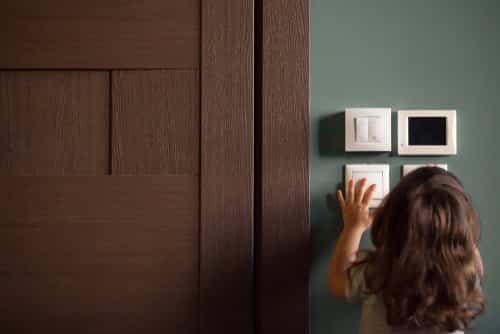Whether your home is new or old, there could be things wrong with the electrical work that you are unaware of. Oftentimes, these issues are never noticed until someone gets hurt or a fire occurs.
It?s important to have an inspection of your home?s electrical system by one of our experienced Knoxville or Atlanta electrical contractors at least once a year.
Of course, we think an experienced electrical contractor should handle each electrical issue, but here are a few items you should be on the lookout for in your home.
Just be careful, and remember to turn the power off at the source before doing any electrical work!
1. Loose Outlet or Switch
Sometimes new homes are built so quickly that adequate care is not taken to secure the outlets properly. Besides being an eyesore, they can be dangerous. Wires can move around and come loose from the terminals, causing them to overheat and potentially catch fire. You can buy plastic spacers to tighten the connection or place small washers around the screws.
2. Cutting Electrical Wires Too Short
Wires that are too short provide a poor electrical connection. More importantly, they can be dangerous. Wires should stick out at least three inches from the electrical box. If you have wires that are too short, you can buy wire connectors that will extend the wires. These are available at home improvement and hardware stores.
3. Exposed Combustible Material from Recessed Electrical Boxes
If an electrical box is behind combustible material like wood paneling, sparks or heat from the wires can cause a fire. You can fix the problem by adding a plastic or metal box extension. This is another problem that many people may not notice themselves, but an experienced residential electrical service provider can find and easy fix.
4. Installing a Three-Slot Receptacle Without a Ground Wire
Many people choose to replace a two-slot outlet with a three-slot one so that they can use three-pronged plug in them. That seems simple enough. However, the outlet has to be grounded in order to do that. To find out if your outlet is grounded before installing a three-slot one, you can purchase a tester. If you find an ungrounded three-slot outlet in your home, just replace it with a two-slot one.
5. Too Many Wires in an Electrical Box
This can cause wires to short-circuit and can be a fire hazard. You can purchase a larger box. These come in plastic and steel. It requires some calculations involving the number of wires and clamps and knowing what gauge wire you have.
If you choose to do this yourself, consult with someone at the store before going to purchase the box to make sure that you?re buying the right size. You may be able to take a clear photo of the wires and clamps to bring to the store with you.
6. No Electrical Box
Wires should never be connected outside of a box. If there is a short circuit or loose connection, there is nothing to protect the surrounding area from damage from sparks and heat. This creates a fire danger. If you have something like a porch light or other electrical connection without a box, you can install one and reconnect the wires within it. As noted above, make sure that you purchase the correct size box for the wiring.
7. Backward-Wired GFCI
Ground fault circuit interrupters (GFCIs) are commonly found in bathrooms and kitchens near sinks and in areas like garages and patios. They protect people from getting shocked by shutting off in there?s a change in the current. GFCIs have two sets of terminals labeled ?line? and ?load.? If these are backwards, they cannot perform their intended function and the results can be deadly. If you discover that the connections are backwards, connect the power to the ?line? terminals.
This is a crucial thing to fix, so if you have any concerns about doing it yourself, contact us to have one of our Knoxville or Atlanta electrical contractors do it. It is also something we can check on a regular inspection.
8. Reversed Hot and Neutral Wires
If a hot, black wire is connected to an outlet?s neutral terminal, the result can be a deadly electrical shock. The white wire should always be connected to the neutral terminal. That terminal is marked, usually with a silver or light-colored screw. Because the mistake doesn?t affect the functioning of the outlet or fixture, most people don?t realize they have this situation until someone is shocked.
If you find this situation, connect the white wire to the neutral terminal (marked by a silver or light-colored screw) and the hot wire to the other terminal. If there is a bare copper wire or green wire, that?s the ground. It needs to be connected to a grounded box, ground wire or the green grounding screw.
9. Missing Cable Clamp
Cable must be secured with a clamp. If it?s not, the connections can become strained. This can be fixed by installing a clamp. If the cables are in a metal box, the sharp edges can cut the wires. Metal boxes must have an approved cable clamp. Plastic boxes have different requirements based on their size.
10. Unprotected Plastic-Sheathed Cable
If this type of cable is left exposed to framing members, it can be easily damaged. This is especially true if it?s around ceiling or wall framing. This can be fixed by either screwing or nailing a 2 x 2 piece of board that?s 1 ? inches thick along the cable. It?s not necessary to staple the cable to the board.
Whether you've just moved into a new home or have been in your home for awhile, it?s advisable to have your electrical outlets inspected by an experienced residential electrical service provider like Pat Murphy Electric. Our experienced technicians can spot problems and fix them before they become potentially disastrous. Call us today to set up an appointment.

